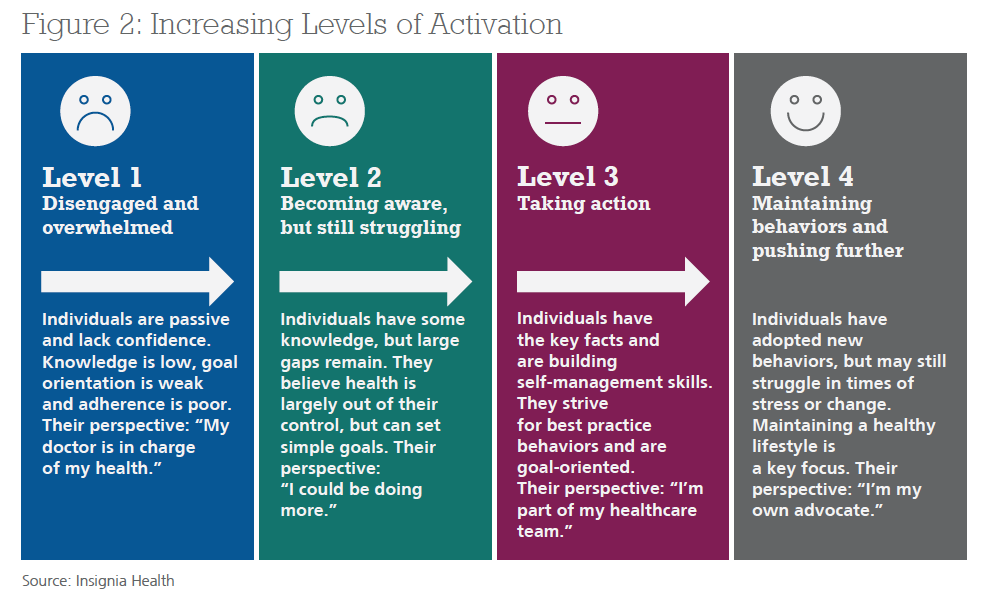The Power of Patient Activation: Part Two
By AmerisourceBergen
Measuring Patient Activation Level to Predict Adherence Tendencies
Improving adherence with targeted patient support begins with understanding a patient’s activation level and the unique adherence barriers the patient faces throughout the treatment journey. Such an approach will trigger proper behavioral changes and involve the patient in his or her own care.
An increasing body of research exists that examines the factors and interventions affecting patients’ ability to self-manage and adhere to treatment. Patient activation is considered to be the most reliable indicator of willingness and ability to manage healthcare autonomously.1
Drawing on this belief, the Patient Activation Measure® (PAM®) survey was developed. Today, the 13-item self-reported questionnaire is used widely to measure the level of empowerment and self-management behaviors, including medication and therapy adherence. Nurses administer the validated survey over the phone, reading the questions word-for-word and capturing patients’ responses on a scale ranging from “strongly disagree” to “strongly agree.” PAM yields a scaled score ranging from 0 to 100 and assigns patients to one of four incremental levels of patient activation, detailed in Figure 2 below.
“Patients with lower activation (PAM levels 1 and 2) are less likely to take their current prescription medications as directed and also less willing to take medications to prevent a disease that they might be at risk for in the future,” says Dr. Judith Hibbard, developer of PAM. “Therefore, treatment and health coaching programs that focus on improving patients’ health self-management behaviors—specifically related to their knowledge, skills and confidence—can directly increase PAM level over time, resulting in improved medication adherence, condition self-monitoring and goal-setting.”

Improving Adherence with PAM and Individualized Care Planning
PAM provides the starting point for understanding a patient’s knowledge, skill and confidence to self-manage his or her health. However, measurement alone is not enough to truly move the needle on improving patient outcomes. Once the clinical support team (a team that is essential for the patient-facing component of any adherence program) understands a patient’s activation level, they conduct motivational interviewing to explore and resolve the resistance interfering with health decision-making. It’s this approach—combining PAM with individualized care planning—that differentiates leading patient support providers.
Therapy compliance can be influenced by assessing the patient’s needs and how they assess their own abilities. While traditional approaches to segmentation take a retrospective view into patient’s past pharmacy behavior to determine an understanding of non-adherence, they don’t solve for the underlying reasons behind why they were non-adherent. This becomes especially important when thinking about helping patients resolve their barriers through development of an individual care plan.
As an alternative to segmentation tools, patient-reported outcome (PRO) assessments can help shed light on and address patients’ specific needs. PRO tools allow for an enhanced approach to patient segmentation as they capture key measurements like attitude, behavior and skills, providing a deeper understanding of lifestyle and daily activity impact.



These tools help nurses appropriately engage and empower patients as they quantify the burden of illness and impact of treatment. The clinical support team works with patients to develop short- and long-term goals to address the medication adherence barriers specific to that patient. As activation improves over time, the team modifies intervention strategies and tailors services to help support patient growth and self-management. Services become “right-sized” to patients—delivering the right support at the right time.
“Using PAM as a foundation, clinical support teams can target goals and action steps that move patients incrementally toward more complex guideline behaviors. By coupling PAM and care planning tailored to a patient’s specific adherence barriers, we’re able to drive improvements in medication adherence and clinical outcomes,” says Dawn Herren, Vice President of Clinical Services at Lash Group, an AmerisourceBergen company.
Dawn herren, vice president of clinical services, lash group
"By coupling PAM and care planning tailored to a patient’s specific adherence barriers, we’re able to drive improvements in medication adherence and clinical outcomes."
For manufacturers, understanding key adherence barriers with specific populations unlocks important insights. Identifying short- and long-term goals that helped improve adherence for a group of patients provides deeper understanding into the treatment journey. These insights can help manufacturers optimize program design and improve outcomes. For example, if transportation to doctor appointments surfaces as a barrier, a manufacturer may consider incorporating transportation as part of the wraparound offering.
Empowering Patients to Make Long-term Behavior Changes
The development and deployment of a successful medication adherence strategy is critical to driving better outcomes. A program design that couples PAM with care planning and PRO enables engagement that addresses patient-specific adherence barriers. This patient-centric approach empowers patients to take an active role in their own health, while ensuring that they receive the maximum benefit from their prescribed medications.


